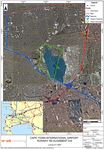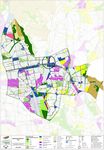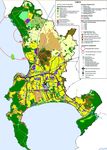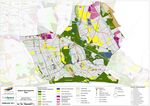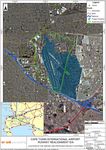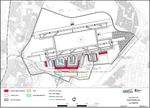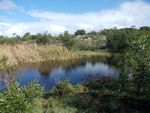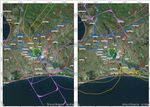Cape Town International Airport Runway Re-alignment and Associated Infrastructure Environmental Impact Assessment Report
←
→
Page content transcription
If your browser does not render page correctly, please read the page content below
Cape Town International Airport Runway Re-alignment and Associated Infrastructure Environmental Impact Assessment Report Report Prepared for Airports Company South Africa SRK Report Number 445354/04 NEAS Reference Number: DEA/EIA/0001606/2012 DEA Reference Number: 14/12/16/3/3/2/446 DEA&DP Reference Number: 16/3/1/6/6/A8/29/1142/12 Report Prepared by March 2015
SRK Consulting: 445354 Cape Town International Airport Runway Re-alignment EIA Report Page i
Cape Town International Airport Runway
Re-alignment and Associated Infrastructure
Environmental Impact Assessment Report
Airports Company South Africa
NEAS Reference Number: DEA/EIA/0001606/2012
DEA Reference Number: 14/12/16/3/3/2/446
DEA&DP Reference Number: 16/3/1/6/6/A8/29/1142/12
SRK Consulting (South Africa) (Pty) Ltd
The Administrative Building
Albion Spring
183 Main Rd
Rondebosch 7700
Cape Town
South Africa
website: www.srk.co.za
Tel: +27 (0) 21 659 3060
Fax:+27 (0) 21 685 7105
SRK Project Number 445354
Compiled by: Peer Reviewed by:
Sharon Jones Chris Dalgliesh
Principal Environmental Consultant Partner and Principal Environmental
Consultant
Email: sjones@srk.co.za
Authors:
Sharon Jones, Scott Masson
JONS/MASS/dalc 445354_CTIA Runway Realignment EIA Report_for public comment March 2015.docx March 2015SRK Consulting: 445354 Cape Town International Airport Runway Re-alignment EIA Report Page iii
Profile and Expertise of EAPs
SRK Consulting (South Africa) (Pty) Ltd (SRK) has been appointed by Airports Company South Africa as
the independent consultants to undertake the Environmental Impact Assessment (EIA) process required
in terms of the National Environmental Management Act 107 of 1998 (NEMA).
SRK Consulting comprises over 1 600 professional staff worldwide, offering expertise in a wide range of
environmental and engineering disciplines. SRK’s Cape Town environmental department has a
distinguished track record of managing large environmental and engineering projects and has been
practising in the Western Cape since 1979. SRK has rigorous quality assurance standards and is ISO
9001 accredited.
As required by NEMA, the qualifications and experience of the key individual practitioners responsible for
this project are detailed below.
Project Director and Reviewer: Christopher Dalgliesh, BBusSc (Hons); MPhil (EnvSci)
Certified with the Interim Board for Environmental Assessment Practitioners South Africa (CEAPSA)
Chris Dalgliesh is a Partner at SRK and the Head of the Environmental Department in Cape Town. He has over 19
years of experience as an environmental consultant working on a broad range of EIA, auditing, environmental
planning and management, stakeholder engagement and environmental management system projects. Chris’s
experience includes managing and co-ordinating major EIAs throughout Southern Africa and South America in the
mining, energy, land-use planning and development, water and waste management, and industrial sectors.
Project Manager: Sharon Jones, BSc Hons (Env. Sci); MPhil (EnviroMan)
Certified with the Interim Board for Environmental Assessment Practitioners South Africa (CEAPSA)
Sharon Jones is a Principal Environmental Consultant with over 17 years of experience, primarily in South Africa,
Southern Africa (Mozambique, Angola and Namibia) and South America (Suriname). Sharon has managed EIAs
across a number of sectors, provided input into due diligence studies, compiled numerous construction and
Operations Phase EMPs for a range of projects, and has audited compliance with EMPs on a number of sites. She is
also involved with the development of Environmental Management Frameworks. Sharon is a registered Professional
Natural Scientist (Environmental Science) with SACNASP and a Certified Environmental Practitioner of South Africa
(CEAPSA).
Statement of SRK Independence
Neither SRK nor any of the authors of this Report have any material present or contingent interest in the
outcome of this Report, nor do they have any pecuniary or other interest that could be reasonably
regarded as being capable of affecting their independence or that of SRK.
SRK has no beneficial interest in the outcome of the assessment which is capable of affecting its
independence.
Disclaimer
The opinions expressed in this report have been based on the information supplied to SRK by Airports
Company South Africa and specialists appointed by SRK. SRK has exercised all due care in reviewing the
supplied information, but conclusions from the review are reliant on the accuracy and completeness of the
supplied data. SRK does not accept responsibility for any errors or omissions in the supplied information
and does not accept any consequential liability arising from commercial decisions or actions resulting from
them. Opinions presented in this report apply to the site conditions and features as they existed at the
time of SRK’s investigations, and those reasonably foreseeable. These opinions do not necessarily apply
to conditions and features that may arise after the date of this Report, about which SRK had no prior
knowledge nor had the opportunity to evaluate.
JONS/MASS/dalc 445354_CTIA Runway Realignment EIA Report_for public comment March 2015.docx March 2015EXECUTIVE SUMMARY: DRAFT ENVIRONMENTAL IMPACT REPORT
CAPE TOWN INTERNATIONAL AIRPORT RUNWAY RE-ALIGNMENT AND
ASSOCIATED INFRASTRUCTURE
NEAS Reference Number: DEA/EIA/0001606/2012
DEA Reference Number: 14/12/16/3/3/2/446
SRK Consulting (South Africa) (Pty) Ltd (SRK) has been
1 INTRODUCTION appointed by Airports Company South Africa to undertake
the Scoping and Environmental Impact Reporting (S&EIR,
Cape Town International Airport, one of three international also referred to as Environmental Impact Assessment
airports in South Africa, currently comprises two active [EIA]) process required in terms of the National
runways: the primary runway (Runway 01-19) and a Environmental Management Act 107 of 1998, as amended
secondary runway (Runway 16-34) bisecting it (Figure 1). (NEMA). SRK has appointed a qualified team of
Airports Company South Africa proposes to re-align the Environmental Assessment Practitioners (EAPs) to manage
primary runway and construct parallel and rapid exit this process.
taxiways. The re-aligned primary runway (Runway 18-36) The Scope of Work assessed in the EIA process includes:
will be 3 500 m in length and will be built to international
x Re-alignment of the primary runway;
specifications, allowing larger (Code F) aircraft to land at
Cape Town International Airport, enabling airport expansion x Construction of associated airport infrastructure (e.g.
and increased airport capacity. Re-aligning the runway will taxiways);
alleviate current development constraints, and will allow for x Bulk earthworks proposed to the east of the airport;
more efficient future expansion of the airport. x Increased capacity potential provided for by the
development in terms of number and/or frequency of
flights and new flight paths facilitated by the
development; and
x Associated increase in (external) public road traffic to
service increased passenger numbers.
See page 8 for details on how you
can participate in the process.
2 GOVERNANCE AND PLANNING FRAMEWORK
Sections 24 and 44 of NEMA make provision for the
identification of activities which may not commence
without an Environmental Authorisation (EA), and stipulate
the requirements for the assessment of such activities. The
EIA Regulations, 2010, are contained in four Government
Notices (GN) issued in terms of NEMA.
GN R543 sets out two alternative procedures for
authorisation processes: depending on the type of activity
that is proposed, either a Basic Assessment (BA) process or
a S&EIR process is required to apply for EA from the
competent authority – in this case the National
Figure 1: Locality Plan Department of Environmental Affairs (DEA). SRK has
determined that the proposed runway re-alignment and
associated infrastructure trigger activities listed in terms of
Listing Notices 1-3 of the EIA Regulations, 2010 (Table 1).
‘n Afrikaanse weergawe van hierdie dokument is beskikbaar – kontak asseblief vir SRK.
Uhlelo lwesiNgesi lolu xwebhu luyafumaneka –qhagamshela i-SRK.Table 1: Listed activities triggered by the Project the revision, the feasibility of a number of layout and land
No Description use planning options was analysed. The Airport Master
Listing Notice 1 (requiring BA) Plan makes provision for the optimised utilisation of the
9 The construction of infrastructure longer than 1 000 m for airport site, ultimately assuming two (re-aligned) primary
the bulk transportation of stormwater. runways. The proposed Project is considered the first key
11 The construction of channels, bulk stormwater outlet step to alleviate current development constraints, allowing
2
structures or 50 m of infrastructure or structures within a
for optimal use of the airport as per the Airport Master
watercourse or within 32 m of a watercourse.
3
18 The infilling or depositing of more than 5 m of any material Plan.
into a watercourse.
2
24 Transformation of land bigger than 1 000 m to residential, 3 ENVIRONMENTAL PROCESS
retail, commercial, industrial or institutional use, where
land was zoned open space, conservation or had an The EIA Regulations, 2010, define the detailed approach to
equivalent zoning.
the S&EIR process, which consists of two phases: the
28 The expansion of or changes to existing facilities for any
Scoping Phase (completed in July 2014) and the Impact
process or activity where such expansion or changes to will
result in the need for a permit or license in terms of Assessment Phase (current phase) (see Figure 2).
national or provincial legislation governing the release of
emissions or pollution.
39 The expansion of channels or bulk stormwater outlet Submit Application Form(s)
structures, within a watercourse or within 32 metres of a
watercourse.
50 The expansion of airports where the development
footprint will be increased. Authority
Listing Notice 2 (requiring S&EIR) Acceptance
5 The construction of facilities or infrastructure for any
process or activity which requires a permit or license in
terms of national or provincial legislation governing the
Scoping Report
generation or release of emissions, pollution or effluent.
7 The construction of runways or aircraft landing strips longer Public Comment
than 1.4 km. Period
The physical alternation of undeveloped, vacant or derelict
15 land where the total area to be transformed is 20 hectares Final Scoping Report
or more.
Listing Notice 3 (requiring BA in the sensitive areas) nd
2 Comment Period
The clearance of an area of 1 ha or more of vegetation
13 where 75% or more constitutes indigenous vegetation Authority
within a Critical Biodiversity Area (CBA). Acceptance
2
The construction of infrastructure covering 10 m or more,
16 where such construction occurs within a watercourse or
within 32 m of a watercourse, within a CBA. *
EIA Report and EMP
Consequently, the proponent is obliged to apply for EA for Public Comment
the Project. Since activities listed under Listing Notice 2 Period
apply to the Project, an S&EIR process is required. Final EIA Report and EMP
A Water Use Licence in terms of section 21 of the National nd
2 Comment Period
Water Act 36 of 1998 (NWA) is required from the
Department of Water and Sanitation. Water use activities Authority
applicable to the Project are listed in Table 2. Decision
Table 2: NWA water use activities for the Project
No Description Appeal lodged
c Impeding or diverting the flow of water in a watercourse. Opportunity for Appeal
Altering the bed, banks, course or characteristics of a
i No appeal lodged
watercourse.
A number of regional plans and frameworks are applicable Project may commence Appeal Process
to the project area and the Project is largely aligned with
the objectives of these plans. Figure 2: S&EIR Process
Note: EMP = Environmental Management Programme
The Airport Master Plan for Cape Town International
Airport was prepared in 2001 and revised in 2006. During
JONS/dalc 445354_CTIA Runway re-alignment_EIA Report_Executive Summary_March 2015 March 2015The Scoping Phase was completed in July 2014 and the Communities adjacent to the airport are highly
Final Scoping Report was accepted by DEA on 30 marginalised with relatively low levels of income.
September 2014.
The EIA has been undertaken in accordance with the Plan
of Study for EIA which was included in the Scoping Report
accepted by DEA. The key objectives of the EIA are to:
x Inform Interested and Affected Parties (IAPs) about the
proposed Project and the EIA process followed;
x Obtain comments from IAPs (including the relevant
authorities and the public) and ensure that all issues,
concerns and queries raised are fully documented and
addressed in the EIA Report;
x Identify and assess potential significant impacts
associated with the proposed development;
x Formulate mitigation measures to avoid and/or Figure 3: Wetland on land east of the airport
minimise impacts and enhance benefits of the Project;
and
5 EXISTING AIR TRAFFIC
x Produce a Final EIA Report which will provide all the
necessary information for DEA to decide whether (and Passenger aircraft arrivals and departures at Cape Town
under what conditions) to authorise the proposed International Airport currently occur between 05h45 and
Project. 23h25 in winter and 05h45 and 00h15 in summer. Three
The EIA Regulations, 2014 do not govern the EIA process. cargo flights operate at 02h00, 03h15 and 04h00. All
aircraft approaching and departing the airport do so either
4 DESCRIPTION OF THE SITE AND ENVIRONMENT by following designated instrument flight paths or by visual
approach, depending on weather conditions and visibility.
Cape Town International Airport is located in the sandy
The existing runway is able to accommodate up to 30
Cape Flats region, immediately north of the N2,
aircraft landing or departing (Air Traffic Movements [ATM])
approximately 20 km east of Cape Town’s Central Business
per hour, but processes around 25 ATM per hour.
District. The current airport property (see Figure 1) is
approximately 975 ha in extent, incorporating the existing
primary and secondary runways, passenger terminal 6 PROJECT DESCRIPTION
buildings to the west of the runways, cargo facilities to the
north and a small portion of undeveloped land to the east 6.1 Project Infrastructure
of the runways. Airports Company South Africa proposes to construct a
In the north-eastern portion of the existing airport new runway, rotated counter-clockwise by 11.5 degrees,
property, Airports Company South Africa is in the process to replace the existing primary runway (Runway 01-19).
of developing a commercial and industrial node (referred The northern end of the new runway (Runway 18-36) will
to as Precinct 3). be positioned 220 m to the east of the current Runway 01-
Further east of the airport property, adjacent to the 19. It will comply with international specifications for Code
existing airport boundary, is a large (~400 ha) portion of F aircraft, increase runway capacity and enable future
derelict land, heavily infested with alien vegetation and airport expansion.
used for illegal activities such as dumping. Small sand In addition to the re-alignment of the primary runway, the
dunes with isolated patches of indigenous vegetation on current Project will also include:
the dune ridges and some small wetlands also occur in this x A taxiway system;
area. Although largely transformed, some wetlands and x Infrastructure such as an aircraft isolation pad (AIP), a
patches of indigenous vegetation are identified as CBAs or compass calibration pad and an aircraft run-up area;
associated support areas. This property is owned by the
x Security facilities including a perimeter fence;
State, Provincial Government and SANRAL. Airports
Company South Africa proposes to acquire this land to x Service roads;
accommodate the Project and future expansion of the x Buildings and service infrastructure;
airport. x Upgrading of the stormwater management system; and
The area surrounding the airport consists of mixed land x Bulk earthworks for the sourcing and on site use of
use including residential, industrial and commercial use. cut/fill material.
JONS/dalc 445354_CTIA Runway re-alignment_EIA Report_Executive Summary_March 2015 March 2015The proposed Project footprint is approximately 700 ha in
extent (Figure 1). Construction is expected to take 24 to 30
months to complete. Construction activities that disrupt No Go alternative: this entails no change to the
operation of the existing runway will take place at night existing runway, which will remain in its current
(for approximately 4 months). position. However, the No Go alternative is not
It is estimated that up to 200 direct temporary jobs will be synonymous with the baseline or status quo, since
created during construction and that between 900 and a number of developments are permitted and/or
3 200 people will be newly and directly employed by may occur whether the runway is re-aligned or
Airports Company South Africa in the long term. not. The number of ATM on the existing runway
may also increase until the runway reaches
6.2 Airport Operations
maximum capacity.
Once the runway is re-aligned, flight paths for aircraft
approaching and departing the airport will change. Runway
18-36 will allow capacity at the airport to increase to 40-44 8 STAKEHOLDER ENGAGEMENT
ATM per hour although aircraft arrival and departure times
Stakeholder engagement is a key component of the S&EIR
are not expected to be extended in the foreseeable future,
process and is being undertaken in accordance with the
due inter alia, to the absence of demand for slots during
requirements of the EIA Regulations, 2010. The key
other (less convenient, passenger-friendly) times.
stakeholder engagement activities during the Impact
Instrument flight paths for Runway 18-36 are illustrated in Assessment Phase are summarised in Table 3 below.
Figure 4.
Table 3: Stakeholder Engagement during Impact
Assessment Phase
Activity Date
Advertisements announcing availability March 2015
of EIA Report for public comment
Public comment period 31 March to 25
May 2015
Focus Group Meetings and Public Open April and May
Days 2015
Second public comment period (if August 2015
required)
Finalise the EIA Report and submit to September 2015
DEA
Key comments and concerns raised by stakeholders
Figure 4: Flight paths for arrival from the south (left) and predominantly related to:
from the north (right) on Runway 18-36
x The changes in noise levels associated with
increased flight frequency and changes in flight
7 ALTERNATIVES paths;
The EIA Regulations, 2010, require that all S&EIR processes x Implications of changes in noise levels on
identify and describe feasible and reasonable alternatives. suitable land use surrounding the airport,
Numerous alternatives were identified and considered implications for property owners and long
during airport master planning, which informed the early term spatial planning;
feasibility and design phases of the Project. x Loss of natural habitats, specifically wetlands;
Re-alignment of the existing runway through counter- x Identification of alternatives for assessment in
clockwise rotation is the only operationally feasible the EIA;
alternative to the existing runway alignment and will allow
x Impacts on current airport operations;
for the future development of a parallel second runway.
x The need and desirability of the Project; and
It is not considered financially feasible nor within Airports
Company South Africa’s mandate to develop a new airport x Potential impacts on the hydrological system
at an alternative when the current site has not been around the airport.
optimised.
Considering the No Go alternative is a requirement of the
EIA Regulations, 2010.
JONS/dalc 445354_CTIA Runway re-alignment_EIA Report_Executive Summary_March 2015 March 2015vegetation clearance, bulk earthworks and increased
Relevant local, provincial and national authorities,
sealed surfaces.
conservation bodies, local forums and surrounding
landowners and occupants have been directly notified of x The predicted impacts on freshwater ecology are
the S&EIR process and the release of the EIA Report for generally rated as low to insignificant, apart from the
comment. loss of endangered Western Strandveld wetland
habitat which is rated as medium and will require a
wetland offset.
9 ASSESSMENT OF POTENTIAL IMPACTS
x The predicted impacts on terrestrial ecology are rated
Specialist studies undertaken to investigate key potential as low to very low, largely due to the disturbed nature
direct, indirect and cumulative impacts are as follows: of the site and limited fauna present in the area.
x Air Quality Specialist Study; x The predicted social impacts are largely linked to
x Noise Specialist Study (and independent review); increased noise levels in communities around the
airport, escalating as the re-aligned runway
x Hydrogeology Specialist Study;
approaches maximum capacity. With predicted
x Freshwater Ecology Specialist Study; exceedances of noise level guidelines in residential
x Terrestrial Ecology Specialist Study; areas up to 15 km from the airport, a significant
x Socio-economic Specialist Study (including analysis of number of people may experience impacts on their
the impacts on land use in areas affected by noise); quality of life. Conversely, many others (though fewer)
and will experience reduced noise levels, which may
improve quality of life. The resultant negative and
x Transport Specialist Study.
positive impacts on different communities are both
For all potentially significant impacts, the significance of rated as high, though the net adverse impact remains
the anticipated impact was rated without and with rated as high. The impact on housing provision by the
recommended mitigation measures. These impacts are City of Cape Town (CoCT) is rated as medium.
presented in Table 4. x The predicted direct economic benefits of the Project
are rated as low during construction and medium
The significance of potential impacts of the proposed
during operations, however the indirect benefits of
Project was determined in order to assist decision-makers.
Relevant observations with regard to the overall impact investment in and stimulation of the regional
ratings, assuming mitigation measures are effectively economy are more substantial, and are rated as high
implemented, are: during operation.
x The predicted heritage impacts are rated as x The predicted visual impacts are rated as low, as the
insignificant, given significant previous disturbance to area is already dominated by existing infrastructure
and the very low heritage sensitivity of the site, and operations at the airport.
although it is plausible that material of archaeological x The predicted transport impacts are rated as very low,
or palaeontological value may be uncovered during since airport-related road traffic is considered
earthworks. negligible in terms of total traffic volumes. Although
x The predicted air quality impact during construction is many of the intersections adjacent to the airport are
rated as insignificant. However, during operations, the currently operating at poor Levels of Service, required
predicted impact of increased emissions on air quality upgrades to alleviate congestion have been identified
is rated as medium. The predicted impact of the for implementation by the relevant roads authorities,
associated risk (incidence) of increased health effects irrespective of the proposed Project.
is rated as low. Given its location in an urban setting, the airport is one of
x The predicted noise and vibration impacts during many contributors to cumulative impacts, and as such, the
construction are rated as insignificant if construction contribution of the Project is expected to be relatively
activities closest to surrounding communities are limited at a regional scale with respect to most cumulative
mitigated. At maximum capacity, the predicted noise impacts. As one of the main contributors to noise in the
impact during operations is rated as high due to the area, the project is however expected to affect cumulative
extent of the area, and communities exposed to, noise levels quite substantially as the runway approaches
exceedances of ambient noise guideline levels. full operational capacity.
x The predicted hydrogeology impacts are rated as very
low, with the primary concern being slightly elevated
local groundwater levels as a consequence of alien
JONS/dalc 445354_CTIA Runway re-alignment_EIA Report_Executive Summary_March 2015 March 2015Table 4 below summarises: Impact Significance Ratings Legend:
Rating +ve -ve
x The impacts assessed in the EIA;
Insignificant I I
x Their significance before and following the
Very Low VL VL
implementation of essential mitigation measures; and
Low L L
x The key mitigation measures on which the significance
Medium M M
rating is based (where applicable).
High H H
Very High VH VH
Table 4: Summary of Impacts
Impact Before After Key mitigation/optimisation measures
Mitigation
Construction Phase Impacts
x Adequately record and obtain a permit to destroy historic structures.
Destruction and Loss of Heritage
I I x Implement a chance finds procedure for heritage material uncovered
Resources
during construction.
x Apply dust suppression methods on all disturbed /exposed areas.
Impact of Construction Activities on x Minimise material handling and travel distances on site.
VL I
Air Quality x Implement a speed limit of 30km/hr on all unpaved roads on site.
x Avoid controlled burning during periods of strong wind.
x Maintain construction equipment in good working order.
Nuisance to Surrounding Receptors x Limit the night time construction activities to the essential.
VL I
caused by Noise during Construction x Limit construction activities to at least 100m from residential areas during
the day and 350m at night. Alternatively install temporary noise barriers.
Nuisance to Surrounding Receptors
I I x No mitigation
caused by Vibration
Impact on Groundwater Levels due
M M x No mitigation
to construction
Impact on Groundwater Quality due x Prevent spills of hydrocarbons or other contaminants.
I I
to construction x Take immediate corrective action should spills occur.
Loss of wetland Habitat and x Identify and implement a suitable wetland offset.
H M
Ecological Structure x Obtain approval from DWS for any activities within wetland areas.
Loss of Ecosystem Services L L x Implement general good housekeeping measures.
x Implement adequate erosion management.
Impacts on Hydrological Function and
L L x Curtail sheet runoff from cleared areas and access roads.
Sediment Balance
x Revegetate cleared areas as soon as possible.
Impacts on Freshwater Features x Implement adequate erosion management.
located outside of the Project L VL x Discharge runoff into freshwater systems beyond the site in such a way as
Footprint Area to prevent erosion.
x Revegetate disturbed areas with grass species indigenous to the region if
Loss of Terrestrial Habitat L L
possible.
Loss of Floral Diversity, Floral SCC and x Rescue and relocate indigenous or protected species and floral SCC.
L VL
Protected Floral Species x Obtain a permit from CapeNature to remove any protected species.
x Rescue and relocate faunal species to a suitable habitat.
Loss of Faunal Diversity, Faunal RDL
L VL x Obtain a permit from CapeNature to remove any protected species.
Species and Protected Faunal Species
x Strictly prohibit hunting and trapping of fauna.
Impacts Associated with Bathyergus x Install mole proof fencing around the airport.
L L
Suillus (Cape Dune Mole Rat) x Rescue and relocate moles to surrounding open veld areas.
Loss of Access to Resources on Land x Offer communities the opportunity to remove combustible material
L L
East of Existing Airport (firewood), prior to earthworks
Nuisance Effects of Construction x Notify residents and schools close to the site of construction schedule.
VL VL
Related Noise x Develop and implement a grievance mechanism.
Generation of Employment, Income x Include in tender documents the need for employment of local labour as
VL VL
and Skills Training far as possible and provision of job-specific training for construction staff.
Increased Revenue to Government I I x No mitigation required.
Increased Investment in and
x Maintain ongoing communication with appropriate business forums to
Stimulation of the Western Cape M M
optimise opportunities for local.
Economy
JONS/dalc 445354_CTIA Runway re-alignment_EIA Report_Executive Summary_March 2015 March 2015Impact Before After Key mitigation/optimisation measures
Mitigation
Altered Sense of Place and visual x Limit removal of vegetation and rehabilitate disturbed areas incrementally.
Quality caused by Construction L VL x Minimise the footprint of the construction camp.
Activities x Maintain the natural topography along the eastern boundary of the site.
Impact of Construction Traffic on the
VL VL x No mitigation required.
Existing Road Network
Operations Phase Impacts
Altered Air Quality from Increased x Initiate a program for the conversion of vehicles and equipment to
M M “cleaner” technology, and use of alternative, less polluting fuels.
Emissions due to Increased ATM
x Encourage policies to reduce high levels of car dependency by staff.
Risk of Health Effects from Air x Investigate and implement mitigation measures aimed at reducing aircraft
L L
Pollution fuel consumption and related emissions.
x Maintain effective communication with affected public regarding noise.
x Integrate grievance mechanism with noise monitoring system to correlate
complaints with noise events and report to authorities.
x Where possible design and implement noise preferential routes.
x Implement take-off, departure and approach procedures aimed at
Noise Impacts of the Re-aligned
reducing noise (e.g. flying at higher altitudes, reduced engine thrust).
Runway and Increased Operational VH H
x Restrict the use of reverse thrust, intersection take-offs and engine ground
Capacity
run-ups between 22h00 and 06h00 unless required for safety reasons.
x Formally engage with the City of Cape Town to encourage airport
compatible land use planning.
x Establish a noise monitoring committee to monitor the effects of noise
mitigation.
Nuisance to Surrounding Receptors
I I x No mitigation
caused by Vibration
Impact on Groundwater Levels due x Provide sub-surface drainage and stormwater systems at edges of
VL VL
to Operations impermeable surfaces.
Impact on Groundwater Quality due
VL VL x No mitigation required.
to Operations
Loss of Wetland Habitat and
I I
Ecological Structure x Implement general good housekeeping measures.
Loss of Ecosystem Services I I
x Drain stormwater from operational areas.
Impacts on Hydrological Function and
I I x Curtail sheet runoff from paved surfaces and access roads.
Sediment Balance
x Attenuate stormwater in order to prevent erosion.
Impacts on Freshwater Features x Minimise paved and sealed surfaces in order to reduce runoff.
located outside of the Project M L x Discharge runoff into freshwater systems off-site in such a way as to
Footprint Area prevent erosion.
x Rescue and relocate faunal species to a suitable habitat.
Loss of Faunal Diversity, Faunal RDL
L VL x Obtain a permit from CapeNature to remove any protected species.
Species and Protected Faunal Species
x Fence the airport to prevent the movement of fauna onto the site.
Impacts Associated with Bathyergus x Maintain mole proof fencing around the airport.
L VL
Suillus (Cape Dune Mole Rat) x Rescue and relocate moles to surrounding open veld areas.
Impacts of Changes in Aircraft Flight
L L x Implement the airport’s Wildlife Management Plan
Paths on Avifaunal Flight Paths
x Assess the risk of bat strikes and if necessary implement measures to avoid
Impacts Associated with Bat Strikes VL VL the creation of habitats or conditions which attract bats or insects on
which bats feed.
x Re-model the noise contours every 5 years to account for changed policies,
improved technologies, altered flight paths and schedules, etc.
x Submit revised noise contours to the CoCT.
Impacts on Quality of Life in Areas x Keep stakeholder informed of changes to predicted noise levels.
VH H
with Increased Noise Levels x Continually identify new noise abatement measures, considering
international trends and best practice for managing noise impacts.
x Develop and implement a grievance mechanism, integrated with the noise
monitoring system to correlate complaints and responses.
Improved Quality of Life in Areas
H H x No optimisation required.
with Decreased Noise Levels
x Re-model the noise contours every 5 years to account for changed policies,
Impacts on Future Housing improved technologies, altered flight paths and schedules, etc.
HIGH HIGH
Developments by CoCT x Submit revised noise contours and encourage the CoCT to consider the
implications of predicted noise (contours) in future land use planning.
JONS/dalc 445354_CTIA Runway re-alignment_EIA Report_Executive Summary_March 2015 March 2015Impact Before After Key mitigation/optimisation measures
Mitigation
Generation of Employment, Income
M M x Prioritise the employment of local people with appropriate skills.
and Skills Training
Increased Revenue to Government M M x No optimisation required.
Increased Investment and
Stimulation of the Western Cape H H x No optimisation required.
Economy
Altered Sense of Place and Visual
L L x Limit lighting to essential activities and facilities and minimise light spillage.
Quality
Impact of Airport-related Road Traffic
VL VL x No mitigation required.
on the Existing Road Network
benefits. The EIA has also assisted in the identification of
mitigation measures that will mitigate the impacts
10 CONCLUSION AND WAY FORWARD
associated with these components to within tolerable
limits (aside from noise). It is anticipated that noise
This Draft EIA Report has identified and assessed the
mitigation measures can and will be explored prior to
potential biophysical and socio-economic impacts
commissioning of the re-aligned runway (if authorised),
associated with the proposed re-alignment of the primary
and implemented. However, in accordance with the
runway and development of associated infrastructure at
precautionary principle, the implementation and efficacy
Cape Town International Airport.
of these measures is not presumed in the Draft EIA Report.
The runway re-alignment will generate a number of
Ultimately, DEA will need to consider whether the Project
significant impacts, but most of these can be reduced to
benefits outweigh the potential impacts.
compliant levels assuming that the recommended
mitigation measures will be effectively implemented.
Indirect economic benefits are also expected to be
relatively significant.
HOW YOU CAN YOU PARTICIPATE IN THE EIA
PROCESS
High (net) noise impacts and associated implications for
land use planning are very difficult to mitigate and current The Draft EIA Report is not a final report and can be
practice suggests communities will continue to demand, amended based on comments received from stakeholders.
and the CoCT continue to provide, housing in areas where Stakeholders’ comments on the EIA Report will assist DEA
existing noise is and is predicted to exceed guidelines. in making a decision regarding the application. The public
Airports Company South Africa is committed to ensuring is therefore urged to submit comment. If you require
that the airport is operated to the highest standards, assistance in compiling and submitting comments, please
achieved through implementation of the recommended contact us and we will ensure that you receive appropriate
mitigation measures and ongoing monitoring of support. Once stakeholders have commented on the
performance. A “Joint Statement of Intent” regarding the information presented in the EIA Report, the Final EIA
mitigation of noise impacts in the short, medium and long Report will be prepared and released for a second public
term was adopted by Airports Company South Africa, comment period before being submitted to DEA for
industry stakeholders and the City of Cape Town. approval. Once a decision is taken by authorities, this
With the exception of noise, the EAPs believe and the EIA decision will be communicated to registered IAPs.
Report demonstrates that, through effective
implementation of the stipulated mitigation measures, the
adverse impacts can be reduced to levels compliant with
guidelines.
SRK believes that sufficient information is available for DEA
to take a decision. The fundamental decision is whether to
authorise the Project, which brings major economic
benefits and is generally consistent with development and
planning policies for the area, but which will generate
noise which exceeds guideline levels in residential
communities, especially once operating at maximum
capacity.
SRK believes that the specialist studies have shown that
the development of the Project is generally acceptable, but
that noise impacts and implications for land use planning
will have to be weighed against the indirect economic
JONS/dalc 445354_CTIA Runway re-alignment_EIA Report_Executive Summary_March 2015 March 2015REVIEW THE REPORT ATTEND A MEETING
Copies of the complete report are available for A number of Public Open Days will be held
public review at the following locations: where the Project will be discussed and
x Cape Town Central Library; additional concerns or issues can be raised:
x Plumstead Library; Public Open Day 1:
x Bellville Library; Venue: Ground Floor, Southern Office Block,
x Somerset West Library; Cape Town International Airport
x Delft Library; Date: 16 April 2015
x Delft South Library; Public Open Day 2:
x Belhar Library; Venue: Bishop Lavis Civic Centre, Adriaanse
x Bishop Lavis Library; Avenue, Bishop Lavis
x Crossroads Library; Date: 07 May 2015
x Manenberg Library; Public Open Day 3:
x Nyanga Library; Venue: Solomon Tshuku Hall, Solomon Tshuku
Ave, Site C
x Philippi East Library;
Date: 11 May 2015
x Elsies River Library;
x Valhalla Park Library; Public Open Day 4:
x Khayelitsha Library; Venue: Bothasig Hall, Link Road, Bothasig
x Edgemead Library; Date: 13 May 2015
Public Open Day 5:
x Cape Town International Airport Southern
Office Block Reception; Venue: Delft Civic Centre, corner Delft Main
Road and Voorbrug Street
x SRK’s Cape Town office; and
Date: 14 May 2014
x SRK’s website: http://www.srk.co.za/en/za-
cape-town-international-airport-runway-re- The public is invited to attend the Public Open
alignment-eia Days at any time between 15h00 and 19h00.
The noise specialist will be available between
16h00 and 18h00.
REGISTER OR PROVIDE YOUR OPINION Please confirm your intention to attend a Public
Register or send written comment to: Open Day with the contact person.
Scott Masson
SRK Consulting
Postnet Suite #206, Private Bag X18,
Rondebosch, 7701
Tel: + 27 21 659 3060
Fax: +27 21 685 7105
Email: smasson@srk.co.za
IAPs are invited to comment, and/or to register on the
project database. IAPs should refer to the DEA reference
number, and must provide their comments together with
their name, contact details (preferred method of
notification, e.g. email), and an indication of any direct
business, financial, personal or other interest which they
have in the application, to the contact person below, by
25 May 2015.
JONS/dalc 445354_CTIA Runway re-alignment_EIA Report_Executive Summary_March 2015 March 2015SRK Consulting: 445354 Cape Town International Airport Runway Re-alignment EIA Report Page iv
Table of Contents
1 Background and Introduction ..................................................................................... 1
1.1 Background ......................................................................................................................................... 1
1.2 Introduction ......................................................................................................................................... 1
1.3 Purpose of the Report ......................................................................................................................... 3
1.4 Scope of Work..................................................................................................................................... 3
1.5 Structure of this Report ....................................................................................................................... 4
1.6 Content of Report ................................................................................................................................ 5
1.7 Assumptions and Limitations .............................................................................................................. 6
2 Governance Framework and Environmental Process............................................... 7
2.1 Legal Requirements ............................................................................................................................ 7
2.1.1 Airports Company Act 44 of 1993 ........................................................................................... 7
2.1.2 Civil Aviation Act 13 of 2009.................................................................................................... 8
2.1.3 White Paper on National Policy on Airports and Airspace Management, 1998 ...................... 8
2.1.4 National Policy on Aircraft Noise and Engine Emissions, 1999 .............................................. 8
2.1.5 National Environmental Management Act 107 of 1998, as Amended .................................... 9
2.1.6 EIA Regulations, 2010 ........................................................................................................... 10
2.1.7 EIA Regulations, 2014 ........................................................................................................... 11
2.1.8 National Water Act 36 of 1998 .............................................................................................. 12
2.1.9 The National Heritage Resources Act 25 of 1999 ................................................................. 13
2.1.10 National Environmental Management: Biodiversity Act 10 of 2004 ...................................... 14
2.1.11 Conservation of Agricultural Resources Act 43 of 1983 ....................................................... 14
2.1.12 Western Cape Nature Conservation Laws Amendment Act 3 of 2000 ................................. 14
2.1.13 National Environmental Management: Air Quality Act 39 of 2004 and the South African
National Air Quality Standards .............................................................................................. 14
2.1.14 Environmental Conservation Act 73 of 1989: Noise Control Regulations and SANS Codes
of Practice ............................................................................................................................. 15
2.1.15 White Paper on National Civil Aviation Policy, 2014 ............................................................. 16
2.1.16 Occupational Health and Safety Act 85 of 1993 ................................................................... 16
2.2 Planning Policy Framework .............................................................................................................. 17
2.2.1 National Development Plan: Vision for 2030......................................................................... 17
2.2.2 Western Cape Spatial Development Framework .................................................................. 17
2.2.3 Western Cape Provincial Land Transport Framework (2013)............................................... 18
2.2.4 Cape Town Spatial Development Framework ...................................................................... 18
2.2.5 Tygerberg District Plan: Spatial Development Plan and Environmental Management
Framework ............................................................................................................................ 20
2.2.6 Khayelitsha Mitchells Plain District Plan: Spatial Development Plan and Environmental
Management Framework ...................................................................................................... 22
2.2.7 Cape Town Integrated Development Plan ............................................................................ 23
2.2.8 Cape Town Zoning Scheme .................................................................................................. 24
JONS/MASS/dalc 445354_CTIA Runway Realignment EIA Report_for public comment March 2015.docx March 2015SRK Consulting: 445354 Cape Town International Airport Runway Re-alignment EIA Report Page v
2.3 Cape Town International Airport Master Plan ................................................................................... 24
2.4 Environmental Assessment Process ................................................................................................ 26
2.4.1 Submission of Applications ................................................................................................... 28
2.4.2 S&EIR Process and Phasing................................................................................................. 28
2.4.3 Appeals.................................................................................................................................. 30
3 Project Description..................................................................................................... 31
3.1 Cape Town International Airport ....................................................................................................... 31
3.2 Introduction to the Project ................................................................................................................. 32
3.3 Description of the Project Area ......................................................................................................... 36
3.3.1 Site Description ..................................................................................................................... 36
3.3.2 Surrounding Land Use .......................................................................................................... 39
3.4 Proponent’s Project Motivation ......................................................................................................... 41
3.5 Project Alternatives ........................................................................................................................... 41
3.5.1 Location Alternatives ............................................................................................................. 42
3.5.2 Airport Master Plan Options .................................................................................................. 43
3.5.3 The No Go Alternative ........................................................................................................... 48
3.6 Project Construction and Infrastructure ............................................................................................ 48
3.6.1 Runway.................................................................................................................................. 49
3.6.2 Taxiways................................................................................................................................ 51
3.6.3 Aircraft Isolation Pad ............................................................................................................. 51
3.6.4 Compass Calibration Pad...................................................................................................... 51
3.6.5 Aircraft Run-up Area.............................................................................................................. 52
3.6.6 Perimeter Fence and Security ............................................................................................... 52
3.6.7 Service Roads ....................................................................................................................... 52
3.6.8 Buildings and Service Infrastructure ..................................................................................... 52
3.6.9 Stormwater Management System ......................................................................................... 52
3.6.10 Bulk Earthworks .................................................................................................................... 55
3.6.11 Construction Traffic ............................................................................................................... 57
3.6.12 Water Supply ......................................................................................................................... 57
3.6.13 Waste Management .............................................................................................................. 58
3.6.14 Air Quality Management ........................................................................................................ 58
3.6.15 Noise and Vibration Management ......................................................................................... 58
3.6.16 Workforce .............................................................................................................................. 58
3.6.17 Investment ............................................................................................................................. 58
3.6.18 Construction Schedule .......................................................................................................... 58
3.6.19 Construction Hours ................................................................................................................ 63
3.7 Project Operations ............................................................................................................................ 63
3.7.1 Air Traffic ............................................................................................................................... 63
3.7.2 Workforce .............................................................................................................................. 65
3.7.3 Operational Lifecycle ............................................................................................................. 65
3.7.4 Utilities and Services ............................................................................................................. 65
JONS/MASS/dalc 445354_CTIA Runway Realignment EIA Report_for public comment March 2015.docx March 2015SRK Consulting: 445354 Cape Town International Airport Runway Re-alignment EIA Report Page vi
3.7.5 Operational Procedures for Pollution Management .............................................................. 65
3.7.6 Waste Management .............................................................................................................. 66
3.7.7 Air Quality Management ........................................................................................................ 66
3.7.8 Noise Management ............................................................................................................... 66
3.7.9 Wildlife Management ............................................................................................................. 67
3.7.10 Emergency Response ........................................................................................................... 67
3.8 Environmental Factors Influencing Project Design ........................................................................... 67
3.9 Analysis of Need and Desirability of the Project ............................................................................... 68
4 Description of the Affected Environment ................................................................. 72
4.1 Biophysical Environment ................................................................................................................... 72
4.1.1 Topography ........................................................................................................................... 72
4.1.2 Geology ................................................................................................................................. 72
4.1.3 Climate .................................................................................................................................. 73
4.1.4 Air Quality .............................................................................................................................. 76
4.1.5 Noise ..................................................................................................................................... 80
4.1.6 Hydrology .............................................................................................................................. 88
4.1.7 Hydrogeology ........................................................................................................................ 90
4.1.8 Freshwater Ecosystems ........................................................................................................ 92
4.1.9 Terrestrial Vegetation ............................................................................................................ 99
4.1.10 Avifauna............................................................................................................................... 103
4.1.11 Fauna .................................................................................................................................. 105
4.2 Socio-Economic Environment ......................................................................................................... 109
4.2.1 Potentially Indirectly Affected Areas: Western Cape and CoCT ......................................... 110
4.2.2 Potentially Directly Affected Areas ...................................................................................... 115
4.2.3 Land Claims ........................................................................................................................ 129
4.3 Heritage Resources and Visual Environment ................................................................................. 130
4.3.1 Heritage Resources ............................................................................................................. 130
4.3.2 Visual and Aesthetic Environment ...................................................................................... 131
4.4 Transport Network........................................................................................................................... 133
4.4.1 External Road Network ....................................................................................................... 133
4.4.2 Long Term Transport Requirements ................................................................................... 136
4.4.3 Traffic Levels around the Airport ......................................................................................... 137
5 Stakeholder Engagement ........................................................................................ 141
5.1 Objectives and Approach to Stakeholder Engagement .................................................................. 141
5.2 Stakeholder Engagement during the Scoping Phase ..................................................................... 141
5.2.1 Identification of Key Stakeholders ....................................................................................... 142
5.2.2 Notification of Start of EIA Process ..................................................................................... 143
5.2.3 Release of Scoping Report for Public Comment ................................................................ 144
5.2.4 Focus Group Meetings and Public Open Days ................................................................... 145
5.2.5 Notification and Acceptance of Final Scoping Report ......................................................... 148
5.2.6 Issues and Concerns Raised by IAPs during Scoping ........................................................ 148
JONS/MASS/dalc 445354_CTIA Runway Realignment EIA Report_for public comment March 2015.docx March 2015You can also read
